The last couple weeks I have been writing about some old ledger books from Chattanooga’s general stores, from 1913-1923. The oldest ledger was from Merkle & Egger’s store and the other two ledgers were from Vining & Dull’s store.
The books had been stored in the attic of the Glenn Miller home in Chatt for nearly 100 years. That home was originally built by store owner Clarence Vining in 1921, which is probably how the attic became home to the books for all those years.
In addition to the three ledger books there were four old Day Books from that same era, also stored away in the Miller attic. While the ledger books listed the accounts of the store patrons, the Day Books recorded what the shoppers actually bought with prices. The Day Books cover the years 1917-22.
I am not certain where the Day Books were actually used. Whether they were used in the store or on the store’s huckster wagon. Yes, these stores had a huckster wagon, like the wagon used by Merkle & Egger.
What was a huckster? A huckster was a person who sold food and small articles door-to-door. The Chatt hucksters were traveling salesmen who brought items from the general store to customers on a regular basis. It was literally a traveling grocery and general store wagon.
From the 19-teens through the Great Depression hucksters traveled door-to-door in horse-drawn wagons and later in motorized trucks. They traveled their specific route every week or two.
Hucksters carried a wide variety of items for sale and trade in their wagons. They carried food, small household items, yard goods, and sewing notions. They had staples such as coffee, sugar, salt, pepper, and spices. Since most of the family’s food came from the farm or was made at home, items like store bought cookies and bread were a luxury and a treat.
The farmer could also trade items with the huckster. The huckster would take the farmer’s homegrown items such as eggs, cheese, and even live chickens in trade. Hucksters carried empty crates and containers to hold and transport the farmer’s trade items. During the Great Depression my grandmother Gertrude Miller was allowed 5 cents a dozen for her eggs in trade.
My dad used to talk about the huckster who came to the farm and said it was quite an event for them. The children would eagerly anticipate the huckster’s arrival while the housewives enjoyed the convenience.
Dorothy Jean (Leininger) Hellwarth said that she always looked forward to getting bologna from the huckster. Her father, Ted Leininger, drove a huckster wagon when he was a young single man. One of the Day Books mentions that Ted stopped driving the huckster wagon in 1917. Ted was also Catherine Miller’s father and Jerry Miller’s grandfather.
It was during Ted Leininger’s huckster days that he met his future bride, Carrie Becher. Before they were married Carrie Becher and Ted Leininger both worked for Clarence Vining, the general store owner in Chatt. Carrie did housework for the Vinings and Ted drove their huckster wagon. And that is how Ted and Carrie met. They married in 1919 and Ted farmed after that.
These Day Books span the years 1917-22. I showed them to Dorothy Jean and after looking through them we believe they are the old huckster books used by Vining & Dull. Dull also owned and operated a creamery in Chatt at one time.
Another thing that makes me think these books were carried on the huckster wagon is that “purchased at store” was written next to some of the lists. I could tell by the names that customers lived in neighboring Adams County, Indiana, as well as Ohio.
Folks pretty much purchased the necessities from the huckster. Items regularly purchased were vinegar, oil, coffee, tobacco (popular item), syrup, rice, sugar, crackers, salmon, matches, tablets, pencils, yeast, lids, overalls, shirting, and thread. I wonder how the salmon was sold. Was it canned?
Other items purchased, but not quite as often, were peanut butter, lemons, oysters, pineapple, catchup, postum, kraut, lye, pineapple, peaches, cocoa, socks, shirts, clasp, stove polish, and brooms.
Even in those days people purchased Grape Nuts, Cracker Jack, and Toasties, brand names we still use today.
Evidently flies were a big problem because they sold a lot of “swatters” and fly powder.
Entries of interest to me from the 1917-19 Day Book are Phil Brewster, my great-grandfather, and Love Brewster, Phil’s stepmother and second wife of Phil’s father Daniel.
Below are just a few of the entries from the Day Books:
On 8 August 1917 Mrs. Evans purchased tobacco, thread, cocoa, percale, oil, sugar, vinegar, coffee, oats and baking powder, totaling $1.71. On the same day May Ketcham purchased Grape Nuts and William Kuhn purchased some ric-rac.
Looking through the books I could not help notice that Fred Wick, William Kuhn, and William Detro were very regular (and good) customers. They may have in fact been their best customers. They purchased a lot. And often. Perhaps they had large families.
On 16 July 1920 Fred Wick purchased tobacco, socks, candy, shirts, butter, cookies, matches, strings, stove polish, soap, salt, beans, sugar, bread, cotton, needle, coffee, syrup, flour, thread, and lids, for a grand total of $13.89.
On the same day Willis Breubaker purchased oil, tomatoes, salmon, hominy, meal, matches, rice, sugar, Cracker Jack, cookies, Toasties, and syrup.
On 12 July Joe Humbert purchased oil, filler, shirt, salt, tapioca, lemon, kraut, raisins, beans, hose, oranges, and a swatter.
On 24 December 1920 my grandfather Carl Miller paid his 22 cent grocery balance.
On 31 December 1920 Philip Brewster purchased oil, sugar, coffee, syrup, cleanser, lye, matches, and thread.
On 11 June 1921 Dewey Carr purchased flour, Vicks salve, sugar, bread, rice, lima beans, kidney beans, and hominy, totaling $3.93.
Fred Wick, 10 June 1921: polish, overalls, netting, sugar, syrup, beans, chicken feed, flour, fly powder, bread, oats, thread, candy, shirting, tacks, soda, socks, and salt; 29 July 1921: candy, mustard, goods, crackers, mat, bread, soap, vinegar, comb, pins, strings, oats, and flour; 10 February 1922: candy, sugar, bread, salt, meal, buck wheat, cookies, thread, flour, corn cake, mustard, starch, ribbon, and crochet cotton.
Howard Caffee paid his 25 cent balance on 5 October 1921.
Some of the hucksters from Chatt were Ted Leininger, Semon Egger, and Elmer Baker. These books are interesting, whether they used them on the huckster wagons or not.

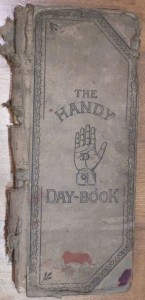
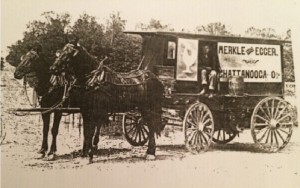
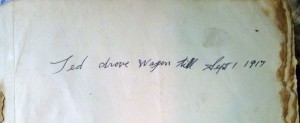

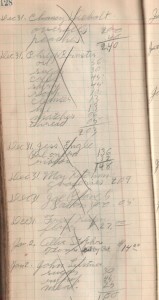
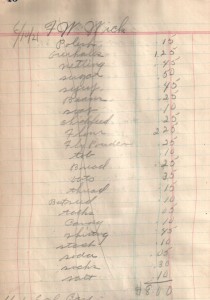
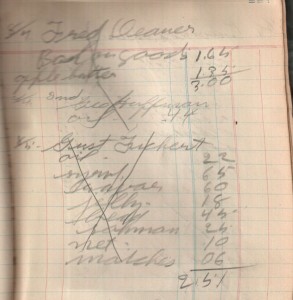


5 comments
Skip to comment form
I have an orange pitcher and 8 glasses made by Fiesta that Grandma Hazel Brewster bought in 1929 from the huckster wagon out of the grocery at New Corydon. She said she paid for it by selling garden produce.
Author
That is so special, Brian! Knowing the history of the glassware makes it even more meaningful. Did they use the set for everyday?
I do not ever remember her using it. It sat on the side board in the dining room as long as I can remember.
Thanks for this post, Karen! My husband’s gg-grandfather was a huckster in Central Ohio, and I never really understood what he actually did, day to day, before now. Your description really brought his occupation to life for me.
Author
Thanks, Shelley!